They All Came Out To Montreux (a highlight of the 23rd edition of the Tribeca Film Festival), Oliver Murray’s fantastic tribute to Montreux Jazz Festival founder Claude Nobs (with remembrances from Quincy Jones, Keith Richards, John McLaughlin, Questlove , Carlos Santana, Roger Glover of Deep Purple, Herbie Hancock, Elvis Costello, Jack White, Ian Anderson, and performances by Aretha Franklin, Nina Simone, Ella Fitzgerald, Roberta Flack, Carole King, Muddy Waters, Etta James, David Bowie, Van Morrison, James Brown, Ray Charles, Marvin Gaye, Buddy Guy, Miles Davis, Prince. Sting, Wyclef Jean, Santana, Gilberto Gil) is hailed by music producer and 99 Records founder Ed Bahlman for the documentary’s composition of musical greatness with the backstory on this one-of-a-kind creation in Montreux.
 |
| Kim Gordon in Sonic Youth at the Montreux Jazz Festival |
Kim Gordon (on her Collective tour), this past Thursday, June 13, 2024 had a Capital One City Parks Foundation SummerStage free concert in Central Park, with Sun Ra Arkestra opening the Subaru Music Series and on July 12, 2000, she performed as Sonic Youth in the Miles Davis Hall at the Montreux Jazz Festival.
From North of London, before coming to New York for the Tribeca Festival, Oliver Murray joined Ed Bahlman and me on Zoom for an in-depth conversation on They All Came Out To Montreux and we touched upon his films Ronnie’s and The Quiet One on Bill Wyman.
Anne-Katrin Titze: Hi, you’re in London?
Oliver Murray: Hi, yeah, just north of London.
AKT: And you are on your way to Tribeca?
OM: Yeah, tomorrow morning. It’s the second time I’ve had a film in Tribeca. The very first film that I made [The Quiet One] had its première in Tribeca.
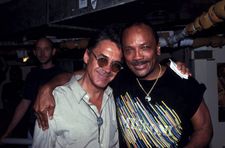 |
| Montreux Jazz Festival founder Claude Nobs with Quincy Jones (executive producer of They All Came Out To Montreux) |
AKT: Five years ago, I think, in 2019?
OM: Yes, it’s nice to have these kind of markers that make you stop and think about what you have been doing. This is a nice kind of full circle for me to come back and maybe be a bit more relaxed about it.
AKT: Tribeca is perfect for this kind of film. When I emailed with [Tribeca artistic director] Frédéric Boyer a few days ago, he said that your new film is wonderful and that he had never been to the festival in Montreux. It was great but too expensive to go there when he was young.
OM: Yeah, you don’t turn up in your tent and just rough it. I thought he would have gone, but that makes sense. I know he’s a huge fan of all those artists on the Atlantic label and being from Nice, I believe. It’s not too far, is it?
AKT: He is from Paris, but in Europe it’s all pretty reachable. How about you? How many times had you been to Montreux to the festival before embarking on this film?
OM: Not too many. I started working in music videos and I made documentaries for myself. The natural fusion of music and documentary filmmaking led me to this run of music documentaries. I certainly didn’t have a plan to work in that particular space. Montreux was interesting twice over for me because I loved the music and heard the records that came out of that.
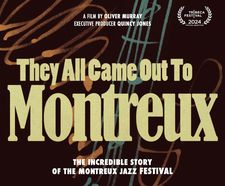 |
| They All Came Out To Montreux |
But everyone told me that up in the mountains above where the festival venues are there is this archive of footage from as early as 1968. Claude Nobs diligently put this archive together. It became this Mecca, slightly separate to the festival itself, that there would be this potential opportunity to get my hands on those tapes and put something together in this golden age of documentary filmmaking that we experienced in the last couple of years. So to hang out there in the archives and put a show together was a dream come true.
AKT: The most famous resident of Montreux, I think, has been Vladimir Nabokov who lived in the Montreux Palace since 1961. Did you come across any interactions between Nabokov and Nobs in your research?
OM: I think one of the strange … It’s easy to look back on it and say the music festival had been a brilliant way of reenergising that part of Switzerland for the next generation. When he started, Claude had this big hill to climb, which was that Montreux is a very quiet place where people come to relax, with spas and things. People that wanted to live in Montreux Palace wanted a life away from the hustle and the bustle of a music festival.
He had some difficult times, because he was such a flamboyant character and wasn’t friends with everybody locally. It took almost his entire lifetime, decades really, for the festival and everything it offered culturally to start to resonate with the local populous who wanted to get away from it and not for the world to descend on their little piece of paradise.
AKT: I’ve been to Montreux, but never to the festival. The town is lovely. My favourite edit in the film comes right after Ella Fitzgerald sings ‘Give me the simple life’ and you cut to Claude waterskiing! Here is your simple life!
OM: That’s absolutely the epitome of Claude. Most people would find a nice quiet corner in the shade to sit and do an interview, it would definitely have been his idea to say, alright, I’m going to waterski onto the pontoon to start my interview! Quite a high-stakes maneuver, given that if he had messed it up, they would have had to start again, wasting all the film. He knew what he was doing with all that kind of stuff. I think he was a great marketeer.
AKT: It must have been an interesting challenge to choose when you let us listen longer to performances, for instance Aretha Franklin in 1971. It’s lovely that you give us so much time fairly early on in the film. Then waterskiing and all the chaos comes in. How were you composing that structure?
OM: I like this expression, come for the music, stay for the story. Because the music is what leads you to a film like this but you need to back it up with a protagonist and feel that the music is emanating from this person’s efforts. If you get it wrong it can feel like two separate energies, two separate films competing with each other. There’s a lot of testing out with tempos of music and story beats. Also that the tone of a performance matches where we are in the story. If it’s a sad moment you want it to resonate but not so much that it’s an illustration of what is going on.
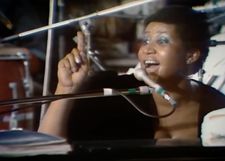 |
| Aretha Franklin at the Montreux Jazz Festival |
It’s a longwinded answer of essentially saying that we experiment a lot to make sure there is this fusion of music and story where they are complementing each other and not getting in the way of each other. Otherwise you should just make The Best of Montreux - of which there are projects like that. Or write a book about Claude. To put them together properly is the number-one hardest challenge, I think. Because people want lots and lots of music, but they also want story.
AKT: And sometimes there are great surprises for the audience, as when suddenly a story gives totally new insight into familiar music, as happens with Under Pressure. Did you know beforehand that this song was a result of, hey you guys [David Bowie and Freddie Mercury of Queen] go to the studio now, while I’m cooking dinner?
OM: Yeah, there’s this rock and roll mythology around Montreux as if there’s something in the water that this magic stuff happens. Even if something tragic happens, like the Casino burning down at the Frank Zappa concert. This kind of crazy positive upshot is Deep Purple’s most famous song. The lyrics are a beat-by-beat description of what happened on that fateful night when the Casino burned down. A couple of things I knew about. I never met Claude and by the end of making the film I had this really quite intimate sense of who I thought Claude was. If I ever met Claude, it would be for me like meeting a friend. It’s a strange scenario when you’re so invested in someone.
 |
| Oliver Murray on Nina Simone: “It’s nice seeing her doing something we are not used to seeing her doing as well.” |
AKT: We can do that, I believe that. We can meet people from former generations through their work, through what they leave behind. Hence the importance of archiving. We keep in touch in a way through time and space. What I also found interesting about Claude Nobs is that he trained as a cook in Basel before starting the festival, returning to Montreux as a local boy. You show all the footage of him cooking for the musicians. Is there a book of Claude’s recipes for musicians? With favourites of Bowie and everybody?
OM: If there isn’t, there should be! If you see that in the next couple of years, that’s because of this conversation by us!
AKT: We’ll look for it!
OM: I think it’s his understanding of hospitality, specifically European, Swiss-German hospitality. It’s only fairly recently that we’re lucky enough to travel as easily as we do. It must have been unbelievable, especially for some of the Black American artists that fly to Europe for the first time. They get to London, which is the same thing with lots of cosmopolitan interests there and then Paris, I’m sure blew their mind.
But then they step off the touring scene and arrive in somewhere like Montreux at the foot of these mountains, go up the funicular, up to his house and have this guy there who is also in charge of Atlantic’s A&R department, this senior guy in the music industry. It’s like an adult Disneyland for music lovers. It’s still an amazing place more than ten years after he’s gone. It must have been astonishing to have him put on one of these parties, this melting pot of Swiss culture and also the American side of things as well, just everyone sharing their music, culture, food - that’s what he was all about.
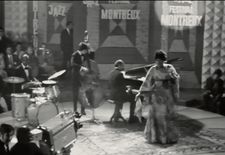 |
| Ella Fitzgerald at the Montreux Jazz Festival |
AKT: He was “Merlin,” which I think is a beautiful way to express it. I have someone here who is a Merlin of sorts here in New York, Ed Bahlman of 99 Records, who would like to say hello to you.
Ed Bahlman: Hello! Great job, really good!
OM: Thank you very much!
EB: When you started it out with James Brown and kept it going for your opening, I had a sense memory of how you started Ronnie’s.
OM: Yes!
EB: With Oscar Peterson giving it his all. In the really great tribute to Claude Nobs, you pulled me in with Aretha trying to find out how much time she had before getting dressed and then she explodes during her performance and becomes a totally different person. The same thing you do when Ella [Fitzgerald] arrives as she tells the cameraperson, you can go to dinner now and then she comes on and she’s dynamite. This is the perfect way to introduce these performers who may not be known by people much younger and showing that they’re real people too.
 |
| Oliver Murray on Claude Nobs: “It would definitely have been his idea to say, alright, I’m going to waterski onto the pontoon to start my interview!” |
OM: Thank you for those kind words. My lane at the moment is music and documentaries and archives and I find myself working with bands and musicians that would now be called legacy artists. Now looking back over my shoulder, I feel a bit the weight of wanting to pass the torch of what those musicians represent.
I feel this weight of responsibility to make sure that when we showcase the likes of Ella and things like that, it’s done with the utmost care to make sure that anyone who is even remotely interested in coming to try to expose themselves to this kind of music feels that these people are fallible human beings just like us. Because once time puts people on pedestals and suddenly they’re not flesh and blood anymore, they just exist as these perfect entities because we only see them onstage performing. As great as that is, you also want to peel away and see behind the curtain.
EB: Yeah.
OM: For me it also goes back to the idea that these artists - it doesn’t come by accident that they are as good as they are. And I think sometimes the world is getting a bit too impatient and it’s nice to see people who dedicated their lives to being as good as they are and it’s a craft. When you see them getting ready, I like seeing when they snap into gear when the lights go on and it’s go-time. For me it’s as important seeing them offstage as onstage.
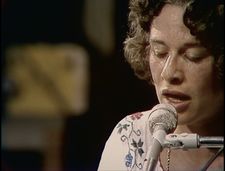 |
| Carole King’s first European performance was at the Montreux Jazz Festival |
I loved seeing the Nina Simone clip although it’s short. It’s nice seeing her doing something we are not used to seeing her doing as well. There’s an astonishingly good Nina show, which lots of people have seen, which we don’t even feature in the film. The film doesn’t exist in a vacuum, so hopefully people who watch this and there’s two or three shows they really liked, they go and find the full hour of whatever it is, Etta or Prince or whoever. There’s 2000 concerts there up in the mountains above Montreux that are there to be seen.
EB: Also the contrast between the two films are the locations: Ronnie Scott’s is the seedy London scene. But you take him [Ronnie Scott] to New York also. West 52nd Street, to get exposed to the American way of showing the jazz scene. And then you have Claude Nobs coming unannounced to Atlantic Records. Then you have all that great footage from the Sixties.
AKT: Yes, beautiful archival choices of the city.
OM: I’m looking forward to watching the film in New York. New York is a major story beat in the film. The whole story of 20th century music is about the sharing of sounds back and forth across the Atlantic. Any music story told properly around that post-war era, it’s like an obligatory scene that you have to have when someone says, either they went to America or they were stationed near an army base that had American Forces Radio, or the boys happened to live in Liverpool where the boats were coming in and the records were coming in.
 |
| Oliver Murray on Bill Wyman: “The Muddy Waters performance you’ve got Bill backing Muddy there. ” |
Around 15 to 20 minutes into any documentary about music in the 20th century, someone has to say, that’s when we heard rock ’n’ roll or that’s when we heard jazz or Charlie Parker and everything changed. It’s almost a clichéd line now of the kids hearing a sound that was theirs. For Claude it was Atlantic Records.
EB: Jazz is unmistakably the American music creation, there’s no other way to look at it. You must have learned so much from editing Ronnie’s in how you were going to edit Montreux. What went through your mind that you wanted to do differently for this one?
OM: When I took on Ronnie’s, I took it on with a really instinctual sense how I wanted to do it because it’s such an important place for me. That’s my town and that’s my place. I was going there with my ears open to learn about new sounds without much, let’s say, academic rigor. When I finished Ronnie’s and thought about Montreux, I thought, I need to come at this with more of a journalistic understanding because it’s a bigger canvas. It’s more than one person’s passion for a particular kind of music.
Actually one of the interesting things about the Montreux Jazz Festival is how it morphs. It starts to include more and more genres of music, now to today. They recently put out a Motörhead LP. Hard rock and all that kind of stuff is as important. It was great to have this flowering and cross-pollination of music but at the same time we needed to box it in because I didn’t want people to arrive and enjoy people like Aretha and Etta [James] and Santana and things and then go off to people like Radiohead and Rage Against the Machine and things like that. Completely different story, different chapter and a different generation of music.
 |
| Van Morrison at the Montreux Jazz Festival |
It’s been interesting to see how jazz, R&B, and rock music - like, what is it that sews together under the skin a comradery between the musicians of seemingly different kinds of music. I think you get to the essence of that if you focus on someone like Claude, who wasn’t really a musician himself. He’s no slouch on the harmonica but I don’t think he would ever call himself a musician. Getting to the heart of what he loved about music, that was my way in. And you end up learning a lot about yourself when you make these.
EB: Also the comments by Keith Richards throughout, that you have them! Because you’ve been working with the Stones?
OM: Yeah, the Stones have been very good to me. Astonishingly good to me, Keith especially.
EB: Because The Quiet One, too, with Bill Wyman. There’s another tie in to the digital music library. You start The Quiet One with his archive being released and he’s a collector. The connection between Bill Wyman and Claude Nobs is so close.
OM: Yes, they were friends. The Muddy Waters performance you’ve got Bill backing Muddy there.
EB: You do?
OM: Yeah, with Dallas Taylor, because Bill liked to go to Montreux and regain a bit of anonymity. If you have a Rolling Stone go to somewhere like Montreux, it meant - and this is marketeering Claude - that with Dallas Taylor and Bill Wyman he could bring over a Black Blues musician, someone Bill so revered. Like when the Stones brought over Howlin’ Wolf. So Bill played with Buddy Guy and Muddy Waters.
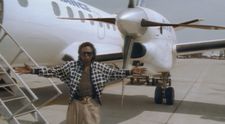 |
| Miles Davis arrives in Montreux |
EB: Oh wow!
OM: He was in heaven. As much as he loved playing with the Stones, that’s the Mecca to actually be on stage with Muddy Waters. That was one of my entry points learning about how special that archive in Montreux was. Bill knew about the collection and was fascinated by what Claude was doing.
EB: Your choices in whom we see performing with so many choices: The fact that you had Van Morrison who said he just came to Montreux to relax, then he rehearses in the afternoon and is performing that night. You also have Van in a structured performance in Ronnie’s. And in Montreux there is a photo of Buddy Rich and in Ronnie’s you have a great clip of him performing. I could see how you were working differently in this one. Because you had already done it with some of these people.
OM: It’s fantastic to hear you make the connections because sometimes I do that almost just for myself. Because I’m not sure how recently people might have seen it. These shows not only take such a long time to make and so long to distribute that sometimes previous films feel like a whole other lifetime. I suppose taste ultimately does come into it. I only put in the stuff that I really like.
 |
| Montreux, Switzerland |
Buddy Rich is such a visceral performer and there’s certain amounts of the things that I like but also I was aware that Claude had spoken a lot about who his favourite musicians were. Given that Claude wasn’t around to collaborate with on the project, I felt the least I could do is be as reverential as possible. If he put together a compilation of his favourite performances, I should do my level best to make sure that it’s a reflection of his taste. I’m sure this is as close as we could get.
EB: It’s great.
AKT: Thank you for this and have a great Tribeca!
OM: Thank you very much! All the best, appreciate the time, take care!
The Tribeca Festival runs through Sunday, June 16.























